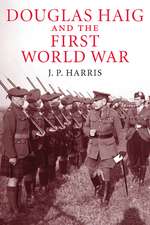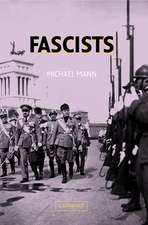Terror and Democracy in the Age of Stalin: The Social Dynamics of Repression
Autor Wendy Z. Goldmanen Limba Engleză Paperback – 26 aug 2007
| Toate formatele și edițiile | Preț | Express |
|---|---|---|
| Paperback (1) | 335.34 lei 6-8 săpt. | |
| Cambridge University Press – 26 aug 2007 | 335.34 lei 6-8 săpt. | |
| Hardback (1) | 690.46 lei 6-8 săpt. | |
| Cambridge University Press – 26 aug 2007 | 690.46 lei 6-8 săpt. |
Preț: 335.34 lei
Nou
Puncte Express: 503
Preț estimativ în valută:
64.17€ • 68.62$ • 53.50£
64.17€ • 68.62$ • 53.50£
Carte tipărită la comandă
Livrare economică 18 aprilie-02 mai
Preluare comenzi: 021 569.72.76
Specificații
ISBN-13: 9780521685092
ISBN-10: 0521685095
Pagini: 286
Dimensiuni: 152 x 229 x 16 mm
Greutate: 0.39 kg
Editura: Cambridge University Press
Colecția Cambridge University Press
Locul publicării:New York, United States
ISBN-10: 0521685095
Pagini: 286
Dimensiuni: 152 x 229 x 16 mm
Greutate: 0.39 kg
Editura: Cambridge University Press
Colecția Cambridge University Press
Locul publicării:New York, United States
Cuprins
1. The social crisis of industrialization; 2. From murder to mass conspiracy; 3. Mobilizing mass support for repression; 4. The campaign for Union democracy; 5. Victims and perpetrators: the organizational dynamics of terror; 6. Rituals of repression in the factories.
Recenzii
“More than any study I know, Goldman’s book brings dramatically to life the day to day reality of the Stalinist Terror. Her accounts of factory meetings are so vivid that you think you are actually there, listening to real people debating, arguing, and betraying one another. Even more important, the book will force us all to rethink our understanding of Stalinism and the dynamics of state repression. This book is a remarkable achievement.”
– Donald Filtzer, University of East London
“This is an important study not only for Soviet historians but for historians interested in labor history, social history, and modern Europe. It will also be of interest to political scientists and sociologists interested in political violence, popular mobilization, and populist components of terror. Goldman captures the complexity of the 1930s, and her book elegantly tells a story that, like real life, is not easy to tell. Avoiding simplistic approaches, she provides a realistic account characterized by confusion, unintended consequences, shifting alliances, and chaos. In doing so, she makes extensive and skillful use of heretofore unexploited and inaccessible archival collections. She uses these unique documents to tell the story of terror and populist ‘democracy’ in the party organizations and factories of Moscow.”
- J. Arch Getty, Professor of History, University of California, Los Angeles
“What does it mean to live inside the Great Terror? Wendy Goldman's richly detailed study adds a new important dimension to our debates on the nature of Stalin's dictatorship in general and on mechanics of the terror in particular.”
- Oleg Khlevniuk, author of The History of the Gulag: From Collectivization to the Great Terror
“In a vivid, analytical narrative Wendy Goldman explores the paradox of Stalin's paroxysm of terror of the late 1930s and the rhetoric – as well as practices – of democracy that accompanied it. Rather than simply a top-down policy of repression or the spontaneous eruption of resentment and revenge from below, the Great Purges are shown to have metastasized from a campaign against party oppositionists into mass arrests and killings of activists, kulaks, and workers. Democratic slogans, even multi-candidate secret ballot elections, were employed to mobilize the rank-and-file in an effort to expel old leaders and ‘revive’ petrified bureaucratic institutions. Professor Goldman gives us the most compelling account to date of how victims and victimizers unwittingly collaborated and consequently destroyed hundreds of thousands of their countrymen and fatally wounded the first ‘socialist’ experiment.”
-Ronald Grigor Suny, Charles Tilly Collegiate Professor of Social and Political History, The University of Michigan, and Professor Emeritus of Political Science and History, The University of Chicago
"This important, readable book sheds light on a critical phase in Soviet history."
Brian Bonhomme, Youngstown State University, The Russian Review
"[The] book, which has the great merit of reminding readers that there was an important social dimension to the Terror, is convincingly argued and abounds in many vivid details. It will be of value to anyone interested in the Stalin years, in particular the institutionalization of the Terror, labour history, popular mobilization, and political violence."
Canadian Journal of History, J.-Guy Lalande, St. Francis Xavier University
– Donald Filtzer, University of East London
“This is an important study not only for Soviet historians but for historians interested in labor history, social history, and modern Europe. It will also be of interest to political scientists and sociologists interested in political violence, popular mobilization, and populist components of terror. Goldman captures the complexity of the 1930s, and her book elegantly tells a story that, like real life, is not easy to tell. Avoiding simplistic approaches, she provides a realistic account characterized by confusion, unintended consequences, shifting alliances, and chaos. In doing so, she makes extensive and skillful use of heretofore unexploited and inaccessible archival collections. She uses these unique documents to tell the story of terror and populist ‘democracy’ in the party organizations and factories of Moscow.”
- J. Arch Getty, Professor of History, University of California, Los Angeles
“What does it mean to live inside the Great Terror? Wendy Goldman's richly detailed study adds a new important dimension to our debates on the nature of Stalin's dictatorship in general and on mechanics of the terror in particular.”
- Oleg Khlevniuk, author of The History of the Gulag: From Collectivization to the Great Terror
“In a vivid, analytical narrative Wendy Goldman explores the paradox of Stalin's paroxysm of terror of the late 1930s and the rhetoric – as well as practices – of democracy that accompanied it. Rather than simply a top-down policy of repression or the spontaneous eruption of resentment and revenge from below, the Great Purges are shown to have metastasized from a campaign against party oppositionists into mass arrests and killings of activists, kulaks, and workers. Democratic slogans, even multi-candidate secret ballot elections, were employed to mobilize the rank-and-file in an effort to expel old leaders and ‘revive’ petrified bureaucratic institutions. Professor Goldman gives us the most compelling account to date of how victims and victimizers unwittingly collaborated and consequently destroyed hundreds of thousands of their countrymen and fatally wounded the first ‘socialist’ experiment.”
-Ronald Grigor Suny, Charles Tilly Collegiate Professor of Social and Political History, The University of Michigan, and Professor Emeritus of Political Science and History, The University of Chicago
"This important, readable book sheds light on a critical phase in Soviet history."
Brian Bonhomme, Youngstown State University, The Russian Review
"[The] book, which has the great merit of reminding readers that there was an important social dimension to the Terror, is convincingly argued and abounds in many vivid details. It will be of value to anyone interested in the Stalin years, in particular the institutionalization of the Terror, labour history, popular mobilization, and political violence."
Canadian Journal of History, J.-Guy Lalande, St. Francis Xavier University
Notă biografică
Descriere
The book shows how ordinary people moved toward madness and self-destruction during the Great Terror.













